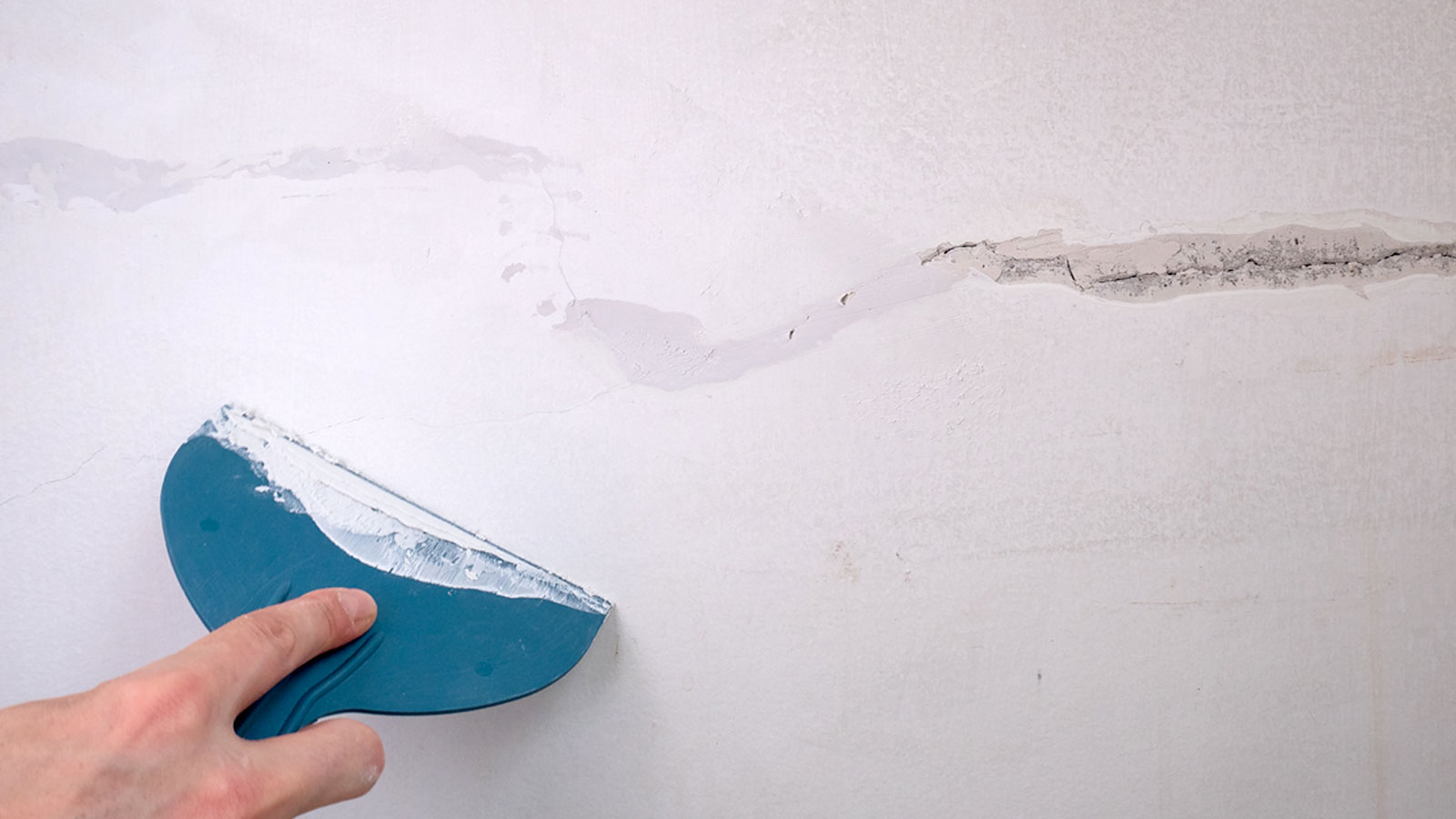How to repair cracks in walls for a smooth and secure finish
Learn how to repair cracks in walls and restore plaster, concrete and brick back to its best. Plus, get expert advice on how to identify structural cracks

If you’ve got unsightly, unwanted cracks in your home you need to know how to repair cracks in walls to stop them getting any worse. Hairline or small cracks in plaster, concrete or mortar are straightforward to fix for any DIYer, and typically not something to worry about.
But if you have larger cracks you might want to think about plastering walls after filling to get a smooth, good-looking finish. But larger cracks in plaster might be hiding an underlying problem that needs the professional eye of a surveyor to determine the issue.
Here we reveal how to remedy everyday cracks in walls along with expert insight on how to spot what might be structural issues.
How to repair cracks in walls
Cracks in walls can take different forms and need different solutions. Here we look at the common problems found in the home and how you can fix them.
Repairing cracks in plaster
One of the most common cracks in the home are those found in the plaster on walls and ceilings. To repair cracks in plaster you will need a decent filler knife like this Stanley Dynagrip Filling Knife from Amazon and a decent filler.
1. Prep crack
Start by brushing out or vacuuming any loose material. Then remove any loose edges with a Stanley knife until the edges are secure. Brush out again to clean up the crack. For larger cracks (more than 3mm or 4mm) brush diluted PVA glue into the crack to help secure and leave to dry.
2. Mix and add filler
Use a general purpose filler like this Everbuild All Purpose Ready Mixed Filler from Amazon or patching plaster. Mix as instructed and place in the centre of the crack and work out. Repeat until filled and then run your filling knife across the crack and filler to get a flat finish.
3. Finish
Leave the filler to dry as recommended by the manufacturer and choose the right sandpaper grade – fine 180 grit is good – to get a smooth finish on the wall ready for redecorating.
How to repair cracks in concrete walls
The size of the crack will determine what approach you take, but there are a few solutions for small and large cracks that will get the job done.
1.Clean the crack
Start by getting wire brushes like these Amazon Basics Brass Mini Brushes for small cracks or a standard wire brush like this Wire Brush Twin Pack from Amazon for larger ones to get rid of any loose debris. Then use a vacuum to remove finer debris.
2. Fill the crack
A liquid concrete filler like this Dortech Metolux Metoset Concrete Repair Resin from Amazon is good for fine and small cracks up to 10mm. Alternatively use a powder filler like this Toupret Exterior Masonry Repair Filler from Amazon. Mix the powder filler and apply with a filling knife. Use a caulking gun to apply the liquid filler.
3. Finish up
Smooth out the filler as best as you can with a filling knife while the filler is still workable. Alternatively use a stiff brush if you don't need a smooth finish. Do this as soon as possible, once the filler has dried it will be harder to shape.
How to repair cracks in brick walls
Cosmetic cracks in brick wall are straightforward to repair, but if a crack is structural you will need to call in a professional.
1. Get rid of debris
Use a stiff brush to clean out the crack – and a screwdriver to hook out debris that the brush can’t reach. If you want a smooth clean removal of the old mortar, use an angle grinder with an appropriate disc. Make sure to brush out or vacuum any dust and debris afterwards.
2. Apply filler or mortar
For small cracks use a liquid concrete filler and a caulking gun to apply the filler. For repointing brickwork on larger cracks use a three-part sand to one-part cement mix. Mix the mortar and apply with a pointing trowel.
When applied use the trowel to smooth out, or a brick jointer like this OX Pro Brick Jointer from Amazon. If the mortar is going to be covered you can use a stiff brush to finish.
FAQs
Should I worry about cracks in walls?
“It really depends on whether the wall is load-bearing and the type, size and pattern of the cracking,” explains Ian Rock, chartered surveyor and director of price comparison website Rightsurvey.co.uk. “The main walls in most buildings carry roof and floor loads, but some interior walls also perform a structural role.”
He continues, “Cracking often manifests itself at weak points in walls, such as around window and door openings, and at junctions with bay windows or extensions. However, most cracks in our homes are not structurally significant. These are often described by surveyors as ‘historic’ and may only require decorative filling or masking."
However, if you live in an older home, beware, says Rock, “Period properties with shallow foundations are particularly prone to developing cracks which open and close over the course of the year reflecting seasonal ground changes. The main worry is where cracking is classed as ‘progressive’ with the potential to affect the structure of the building, such as those related to foundation movement.”
How can you tell if a crack is structural?
Generally you don’t need to panic about cracks in walls, but chartered surveyor Ian Rock gives some guidance on what to look out for and how serious a crack can be. “The Building Research Establishment (BRE) defines cracking in 6 categories from 0 (hairline cracks) up to 5 (extensive or structural damage). But which of these categories should you worry about? “Cracks visible on both sides of the wall and wider than about 5mm (BRE categories 3 to 5) are more likely to be structurally significant.”
Rock continues and reveals some of the reasons for structural cracks and what you should do. “Cracking below DPC level is another common symptom of possible foundation movement. Potential causes of significant cracking include issues such as ground instability (often linked to trees and clay subsoils), cavity wall tie failure, botched structural alterations, roof thrust, thermal movement, differential movement, timber decay, and defective original design & construction. Diagnosing the specific causes of cracking can be complex and should be carried out by a qualified Structural Engineer or Building Surveyor.”

Chartered surveyor Ian Rock MRICS is a director is Rightsurvey.co.uk and the author of eight popular Haynes House Manuals, including the Home Extension Manual, the Self Build Manual and Period Property Manual.
Ian is also the founder of Zennor Consultants. In addition to providing house surveys, Zennor Consultants provide professional guidance on property refurbishment and maintenance as well as advising on the design and construction of home extensions and loft conversions, including planning and Building Regulations compliance.
If you can fix a crack in your wall, painting a wall will be the next step to get it back to its best. But if you have a more serious problem you might need to know how to plaster a wall to get a super smooth finish to hide your repairs.
Get the Homebuilding & Renovating Newsletter
Bring your dream home to life with expert advice, how to guides and design inspiration. Sign up for our newsletter and get two free tickets to a Homebuilding & Renovating Show near you.
Steve Jenkins is a freelance content creator with over two decades of experience working in digital and print and was previously the DIY content editor for Homebuilding & Renovating.
He is a keen DIYer with over 20 years of experience in transforming and renovating the many homes he has lived in. He specialises in painting and decorating, but has a wide range of skills gleaned from working in the building trade for around 10 years and spending time at night school learning how to plaster and plumb.
He has fitted kitchens, tiled bathrooms and kitchens, laid many floors, built partition walls, plastered walls, plumbed in bathrooms, worked on loft conversions and much more. And when he's not sure how to tackle a DIY project he has a wide network of friends – including plumbers, gas engineers, tilers, carpenters, painters and decorators, electricians and builders – in the trade to call upon.

